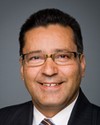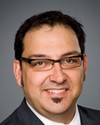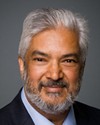Good afternoon, Mr. Chair and committee members. My name is Scott Jobin-Bevans. I am president of the Prospectors and Developers Association of Canada, or PDAC. I'm here with Glenn Nolan, the PDAC's first vice-president. We are both volunteers with the association and our careers are actually in the mineral industry. I'm a geologist by training. I've worked all around the world for the last 20 years in geological consulting. I'm a co-founder of a consulting company, Caracle Creek, and have been exposed to many areas of our industry on the mining and exploration side.
Glenn works with Noront Resources, where he's vice-president, aboriginal affairs, and if you know Noront Resources, you'll know it is involved with the Ring of Fire discovery area in Ontario, in the James Bay lowlands. Glenn is also a member of the Missanabie Cree First Nation and a past chief.
The PDAC represents about 8,000 members, individual and corporate. We exist to protect and promote mineral exploration and to ensure a robust mining industry in Canada and for our membership around the world. We encourage the highest standards of technical, environmental, safety, and social practices in Canada and internationally.
I do thank you for the invitation to be here today and to offer our comments on skills development in remote rural communities.
The mining industry, and in particular the mineral exploration sector, is familiar with the matters being studied by this committee. Our member companies operate in remote areas of Canada. Many of the operations are small scale, with perhaps half a dozen full-time employees and a great number of seasonal staff performing a variety of tasks in support of mineral exploration. Across Canada, mineral exploration and mining are the lifeblood for small rural communities.
Throughout the economic turmoil of the past few years, exploration and mining companies have continued to invest in Canadian projects, creating jobs and new businesses that support the industry. Many of these businesses are aboriginal owned and operated, and this leads to new opportunities throughout the country. Our mining industry is a story of success and a fundamental driver of Canada's economy.
In 2010, the mining industry paid some $8.4 billion to governments in taxes and royalties and employed well over 300,000 people. The mining industry is the largest private sector employer of aboriginal Canadians. Since 1996, the mining sector has seen an increase of 43% in its aboriginal workforce, and aboriginal Canadians now make up about 7.5% of the mining labour force.
Mineral exploration is the essential first step in the mining cycle, and Canada does have a number of features that make it a very attractive investment and, as we like to say, number one in the world. We have good geology, good information available through our public geoscience mapping programs, a workforce with access to a number of training initiatives, and a very competitive tax system that includes our flow-through share financing and the mineral exploration tax credit, both of which are unique to Canada and make us the envy of the world. In 2011, it is estimated that exploration expenditures in Canada will exceed $3.1 billion, a significant increase over the $2.6 billion that was invested in 2010.
This committee is interested in identifying ways of encouraging economic and skills development in remote rural communities, including public-private partnerships, best practices, aboriginal education, and encouraging the private sector to invest more in these communities.
The first two recommendations in the Canadian Chamber of Commerce report, “The Business Case for Investing in Canada's Remote Communities”, focus on education and training, calling on the federal government to review the funding formula for education in first nations communities to ensure parity with the provincial financing model and to ensure the skills and training programs are flexible enough to accommodate the economic realities of individual communities. There are many good recommendations in this report, and it is appropriate that education and training be given this attention.
The report also mentions private sector initiatives, and I'd like to talk about one at the PDAC that is fundamental to the work we do. It's called the PDAC Mining Matters. Mining Matters is a charitable organization dedicated to bringing Canada's geology and mineral resources to students, educators, and the general public. The organization provides current information about rocks, minerals, metals, and mining, and offers exceptional educational resources that meet provincial curriculum expectations. Core to the program are the Mining Matters junior, intermediate, and senior educational resources, created by educators and earth science experts.
Mining Matters has reached an estimated 450,000 teachers, students, and members of the general public since its inception in 1994. This is an impressive number. Mining Matters is now in its 11th year of offering aboriginal youth outreach programs, which include educational summer camps for ages 9 to 65, professional development workshops for teachers, and student workshops.
Since 2003, Mining Matters has delivered 41 workshops to 363 teachers in aboriginal communities, who oversee the education of an estimated 5,400 students. Since 2006, Mining Matters has delivered 19 mining rocks earth science camps for aboriginal communities, reaching 485 youths and adults. The earth science camps are designed to engage the youth in resource materials, field trips, authentic data, and activities that explore the technological advances that have made Canada a world leader in mineral exploration and mining.
In 2010, Mining Matters organized a workshop in Baker Lake, which brought together youth from five Nunavut communities. The program was conducted at the site of Agnico-Eagle's Meadowbank Mine. In 2011, Mining Matters delivered 10 earth science camps for aboriginal communities in Ontario and Manitoba, reaching nearly 250 youths and adults with our specialized learning activities. The camp engages many partners from industry, government, academia, and aboriginal communities.
Benefits of the aboriginal outreach program include educational initiatives that improve the quality of education for youth, including literacy, science and math, teamwork, technology, problem solving, critical thinking, earth sciences, mineral exploration, mining, the environment, and future career opportunities.
The program is organized with aboriginal input for all community camps. It supports the local economy, including opportunities for staff employment in camp as well as in services and supply. This leads to enhanced relationships between aboriginal communities, resource sectors, and government.
If members of the committee would like more information on the Mining Matters program, we'd be pleased to provide it.
I must stress that the Mining Matters program has no core government funding. It receives its funding through fundraising, and more than half of it comes through donations from individuals and corporate people. It is quite a successful program.
In conclusion, I'd like to thank the committee again for giving us this opportunity. Glenn Nolan and I would be happy to answer any questions you may have.




